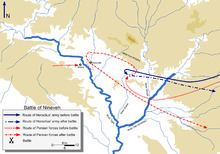25,000-50,000 12,000 Date 12 December 627 AD | Unknown 6,000 | |
 | ||
Similar Byzantine–Sasanian War of 602–628, Siege of Constantinople, Roman–Persian Wars, Byzantine–Sasanian wars, Battle of Samarra | ||
The Battle of Nineveh (Ἡ μάχη τῆς Νινευί) was the climactic battle of the Byzantine-Sassanid War of 602–628. The Byzantine victory later resulted in civil war in Persia and for a period of time restored the Roman empire to its ancient boundaries in the Middle East. This resurgence of power and prestige was not to last, as within a matter of a few years, an Arab Caliphate emerged from Arabia and once again brought the empire to the brink of destruction.
Contents
Prelude
When Emperor Maurice was murdered by the usurper Phocas, Khosrau II declared war, ostensibly to avenge his benefactor's death. While the Persians were successful during the first stages of the war, conquering much of the Levant, Egypt, and even Anatolia, the ascendancy of Heraclius eventually led to the Persians' downfall. Heraclius' campaigns altered the balance, forcing the Persians on the defensive and allowing for the Byzantines to regain momentum. Allied with the Avars, the Persians attempted to take Constantinople, but were defeated.
While the Siege of Constantinople was taking place, Heraclius allied with what Byzantine sources called the Khazars under Ziebel, who are identified with the Western Turkic Khaganate of the Göktürks led by Tong Yabghu, plying him with wondrous gifts and a promise of the reward of the porphyrogenita Eudoxia Epiphania. The Caucasus-based Turks responded by sending 40,000 of their men to ravage the Persian empire in 626 to start the Third Perso-Turkic War. Joint Byzantine and Göktürks operations were focused on besieging Tiflis.
Invasion of Mesopotamia
In mid-September 627, leaving Ziebel to continue the siege of Tiflis, Heraclius invaded the Persian heartland, this time with between 25,000 and 50,000 troops and 40,000 Göktürks. The Göktürks, however, quickly deserted him because of the strange winter conditions. Heraclius was tailed by Rhahzadh's army of 12,000, but managed to evade Rhahzadh and invaded the heartland of the Persian Empire, in Mesopotamia (modern Iraq). Heraclius acquired food and fodder from the countryside, so Rhahzadh, following through countryside already stripped, could not easily find provisions. This resulted in harm to Rhahzadh's animals.
On 1 December, Heraclius crossed the Great Zab River and camped near the ruins of the capital of the former Assyrian Empire of Nineveh in Persian ruled Assyria/Assuristan. This was a movement from south to north, contrary to the expectation of a southward advance. However, this can be seen as a way to avoid being trapped by the Persian army in case of a defeat. Rhahzadh approached Nineveh from a different position. News that 3,000 Persian reinforcements were approaching reached Heraclius, forcing him to act. He gave the appearance of retreating from Persia by crossing the Tigris.
Field of battle
Heraclius had found a plain west of the Great Zab some distance from the ruins of Nineveh. This allowed the Byzantines to take advantage of their strengths in lances and hand-to-hand combat. Furthermore, the fog reduced the Persian advantage in missile troops and allowed the Byzantines to charge without great losses from missile barrages. Walter Kaegi believes that this battle took place near Karamlays Creek.
Battle
Rhahzadh deployed his forces into three masses and attacked. Heraclius feigned retreat to lead the Persians to the plains before reversing his troops to the surprise of the Persians. After eight hours of fighting, the Persians suddenly retreated to nearby foothills, but it was not a rout. 6,000 Persians fell.
Nikephoros' Brief History tells that Rhahzadh challenged Heraclius to personal combat. Heraclius accepted and killed Rhahzadh in a single thrust; two other challengers fought and also lost. In any case, Rhahzadh died sometime in the battle.
The 3,000 Persian reinforcements arrived too late for the battle.
Aftermath
The victory at Nineveh was not total as the Byzantines were unable to capture the Persian camp. However, this victory was significant enough to shatter the resistance of the Persians.
With no Persian army left to oppose him, Heraclius' victorious army plundered Dastagird, Khosrau's palace, and gained tremendous riches while recovering 300 captured Byzantine/Roman standards accumulated over years of warfare. Khosrau had already fled to the mountains of Susiana to try to rally support for the defense of Ctesiphon. Heraclius could not attack Ctesiphon itself because the Nahrawan Canal was blocked by the collapse of a bridge.
The Persian army rebelled and overthrew Khosrau II, raising his son Kavadh II, also known as Siroes, in his stead. Khosrau perished in a dungeon after suffering for five days on bare sustenance—he was shot to death slowly with arrows on the fifth day. Kavadh immediately sent peace offers to Heraclius. Heraclius did not impose harsh terms, knowing that his own empire was also near exhaustion. Under the peace treaty, the Byzantines regained all their lost territories, their captured soldiers, a war indemnity, and of great spiritual significance, the True Cross and other relics that were lost in Jerusalem in 614. The battle marked the end of the Roman-Persian Wars.
